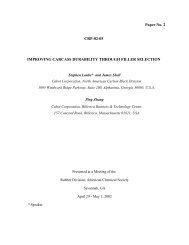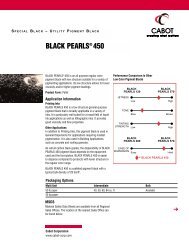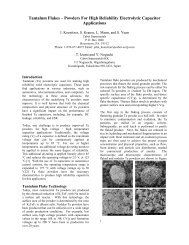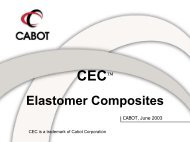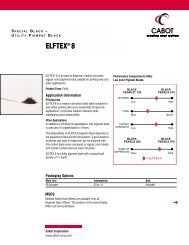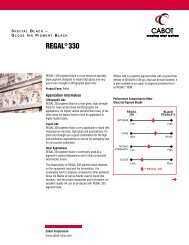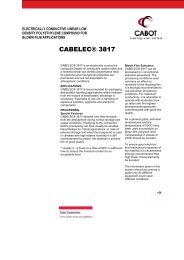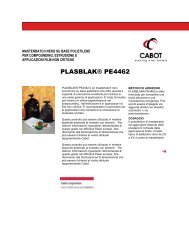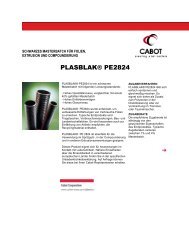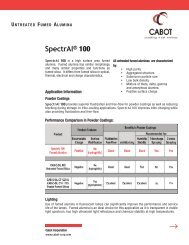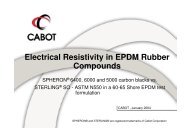From a processing point of view, mixing is the most critical process ...
From a processing point of view, mixing is the most critical process ...
From a processing point of view, mixing is the most critical process ...
Create successful ePaper yourself
Turn your PDF publications into a flip-book with our unique Google optimized e-Paper software.
Use <strong>of</strong> Cabot Elastomer Composite Materials in Mining ApplicationsCabot Corporation, Boston, MA<strong>From</strong> a <strong><strong>process</strong>ing</strong> <strong>point</strong> <strong>of</strong> <strong>view</strong>, <strong>mixing</strong> <strong>is</strong> <strong>the</strong> <strong>most</strong> <strong>critical</strong> <strong>process</strong> for rubber compounding.The primary functions <strong>of</strong> <strong>mixing</strong> are incorporation, d<strong>is</strong>persion and d<strong>is</strong>tribution <strong>of</strong> <strong>the</strong> filler and o<strong>the</strong>ringredients in elastomeric polymers. Chemical reactions among <strong>the</strong> rubber components may occur aswell. Traditionally, th<strong>is</strong> <strong>is</strong> achieved by using batch <strong>mixing</strong> or continuous <strong>mixing</strong> <strong>of</strong> dry fillers andsolid rubber or pellets, referred to as dry <strong>mixing</strong>.During <strong>the</strong> last few decades, a great effort has been made to produce carbon black-filledpolymer masterbatches by <strong>mixing</strong> liquid-state polymer latex with filler slurry and <strong>the</strong>n coagulating <strong>the</strong>mixture chemically. The commercial products are generally made by a batch <strong>process</strong>. With th<strong>is</strong> <strong>process</strong>,<strong>the</strong> filler d<strong>is</strong>persion generally can be improved relative to dry <strong>mixing</strong>. However, long <strong>mixing</strong> andcoagulation times reduce <strong>the</strong> productivity <strong>of</strong> <strong>the</strong>se <strong>process</strong>es.Cabot Elastomer Composite (CEC) describes elastomer masterbatch produced via a uniquecontinuous liquid phase <strong>mixing</strong>/coagulation <strong>process</strong>. During th<strong>is</strong> <strong>process</strong>, filler incorporation,d<strong>is</strong>persion and d<strong>is</strong>tribution are completed in a very short period <strong>of</strong> time. For carbon black – filledmasterbatches, it has been found that th<strong>is</strong> liquid phase <strong>mixing</strong> <strong>of</strong>fers <strong>the</strong> following benefits over <strong>the</strong>conventional dry <strong>mixing</strong> and wet batch <strong><strong>process</strong>ing</strong>:• Excellent d<strong>is</strong>persion <strong>of</strong> filler independent <strong>of</strong> filler morphology;• Improved vulcanizate properties, including significantly improved hysteres<strong>is</strong>, abrasionres<strong>is</strong>tance, cut chip res<strong>is</strong>tance, and flex fatigue performance, and reduced crack growthinitiation and propagation; and• O<strong>the</strong>r manufacturing and commercial benefits.The advantages <strong>of</strong> carbon black-natural rubber materials produced using th<strong>is</strong> <strong>process</strong> have beend<strong>is</strong>cussed in several publications and patents. 1 Rubbers mixed using <strong>the</strong> CEC <strong>process</strong> and having highloadings <strong>of</strong> filler such as carbon black exhibit higher abrasion res<strong>is</strong>tance than rubbers mixed using dry<strong>mixing</strong> <strong>process</strong>es. In addition, tires incorporating rubbers mixed using <strong>the</strong> CEC <strong>process</strong> exhibit lowerrolling res<strong>is</strong>tance and lower heat build-up than tires incorporating dry mixed rubbers. Tire treadcompounds incorporating rubbers mixed using <strong>the</strong> CEC <strong>process</strong> exhibit improved cut-chip res<strong>is</strong>tance,and rubbers mixed using <strong>the</strong> CEC <strong>process</strong> exhibit much longer fatigue life than rubbers produced bydry <strong>mixing</strong>.1 See, for example, M.-J. Wang, et al., “NR/Carbon Black Masterbatch Produced with Continuous Liquid Phase Mixing,”KGK Kautschuk Gummi Kunstst<strong>of</strong>fe, vol. 55, 7-8/2002, pp 388-396.Page 1
The superior performance exhibited by rubbers produced using <strong>the</strong> CEC <strong>process</strong> can alsobenefit <strong>the</strong> mining industry. Tires abrade against a variety <strong>of</strong> surfaces, not just roads. Vehiclesequipped with tires run on dirt and rock surfaces, including in mine shafts, which are not alwayssmooth and may have jagged protrusions. As ores and slurries are transported at mining sites, <strong>the</strong>yabrade against all <strong>the</strong> equipment used to move and <strong>process</strong> <strong>the</strong>m, including grinding mills,hydrocyclones, pumps, chutes, conveyors, and screens. As th<strong>is</strong> equipment wears, production must bepaused to replace worn components. By improving wear performance, <strong>the</strong> CEC <strong>process</strong> increases <strong>the</strong>lifetime <strong>of</strong> <strong>the</strong> resulting materials, <strong>the</strong>reby reducing material, downtime, and labor costs.Th<strong>is</strong> paper d<strong>is</strong>cusses CEC production and various mining applications in which CEC materialscan provide advantageous performance.CEC ProductionThe starting materials for <strong>the</strong> CEC <strong>process</strong> are an elastomer latex emulsion and a filler slurry.The particulate filler fluid may be aqueous carbon black slurry or any o<strong>the</strong>r appropriate filler d<strong>is</strong>persedin a fluid and selected for <strong>the</strong> intended use <strong>of</strong> <strong>the</strong> elastomer masterbatch product. In addition to carbonblack and silica-type fillers, d<strong>is</strong>cussed in more detail below, fillers can be formed <strong>of</strong> clay, glass, orpolymer particles or fibers. Additives may be pre-mixed with <strong>the</strong> particulate slurry or with <strong>the</strong>elastomer latex fluid or may be added during coagulation. Additives also can be added subsequently,e.g., by dry <strong>mixing</strong> techniques. Additives include, for example, antioxidants, antiozonants, plasticizers,<strong><strong>process</strong>ing</strong> aids (e.g., liquid polymers, oils and <strong>the</strong> like), resins, flame-retardants, extender oils,lubricants, etc.The CEC <strong>process</strong> <strong>is</strong> described in U.S. Patent No. 6,048,923. In brief, a slurry <strong>of</strong> carbon black oro<strong>the</strong>r filler and a natural rubber latex fluid or o<strong>the</strong>r suitable elastomer fluid are fed simultaneously to a<strong>mixing</strong> zone <strong>of</strong> a coagulum reactor. A coagulum zone extends from <strong>the</strong> <strong>mixing</strong> zone, preferablyprogressively increasing in cross-sectional area in <strong>the</strong> downstream direction from an entry end to ad<strong>is</strong>charge end. The slurry <strong>is</strong> fed to <strong>the</strong> <strong>mixing</strong> zone preferably as a continuous, high velocity jet <strong>of</strong>injected fluid, while <strong>the</strong> elastomer latex fluid <strong>is</strong> fed at relatively low velocity. The high velocity, flowrate and particulate concentration <strong>of</strong> <strong>the</strong> filler slurry are sufficient to cause mixture and high shear <strong>of</strong><strong>the</strong> latex fluid, flow turbulence <strong>of</strong> <strong>the</strong> mixture within at least an upstream portion <strong>of</strong> <strong>the</strong> coagulum zone,and substantially completely coagulate <strong>the</strong> elastomer latex prior to <strong>the</strong> d<strong>is</strong>charge end. Substantiallycomplete coagulation can thus be achieved without <strong>the</strong> need for an acid or salt coagulation agent.After <strong>the</strong> substantially complete coagulation <strong>of</strong> <strong>the</strong> elastomer latex and particulate fluid,masterbatch crumb in <strong>the</strong> form <strong>of</strong> "worms" or globules <strong>is</strong> formed and d<strong>is</strong>charged from <strong>the</strong> d<strong>is</strong>chargePage 2
end <strong>of</strong> <strong>the</strong> coagulum reactor as a substantially constant flow concurrently with <strong>the</strong> on-going feeding <strong>of</strong><strong>the</strong> latex and filler slurry streams into <strong>the</strong> <strong>mixing</strong> zone <strong>of</strong> <strong>the</strong> coagulum reactor. Notably, <strong>the</strong> plug-typeflow and atmospheric or near atmospheric pressure conditions at <strong>the</strong> d<strong>is</strong>charge end <strong>of</strong> <strong>the</strong> coagulumreactor are highly advantageous in facilitating control and collection <strong>of</strong> <strong>the</strong> elastomer compositeproduct, such as for immediate or subsequent fur<strong>the</strong>r <strong><strong>process</strong>ing</strong> steps. The masterbatch crumb <strong>is</strong>created and <strong>the</strong>n formed into a desirable extrudate, which <strong>is</strong> <strong>the</strong>n dewatered in a suitable apparatus.The resulting dewatered coagulum may be passed through a dryer or masticated and driedsimultaneously. As described in PCT Application No. PCT/US2009/000732, <strong>the</strong> input <strong>of</strong> mechanicalenergy into <strong>the</strong> dewatered coagulum via mastication may be controlled with respect to a drying pr<strong>of</strong>ile.The masticated masterbatch may be dry mixed with any <strong>of</strong> <strong>the</strong> additives described above, forexample, additional filler or a different type <strong>of</strong> filler (e.g., addition <strong>of</strong> silica to a carbon black-naturalrubber masterbatch) or with additional elastomer, for example, butadiene rubber, as described in U.S.Patent No. 7,105,595. Alternatively or in addition, <strong>the</strong> masticated masterbatch may be fed to a coolingsystem or granulator as described in U.S. Patent No. 6,929,783. The granulated material may <strong>the</strong>n befed to a baler, where <strong>the</strong> granulated material may be baled more or less tightly or densely. Forexample, where <strong>the</strong> masterbatch will be compounded in a Banbury mixer or <strong>the</strong> like, it may bedesirable to prepare a loose bale such as that described in PCT Publication WO03/042285.Performance <strong>of</strong> CEC materialsMicroscopic observation <strong>of</strong> CEC compounds and dry-mixed rubbers reveals that filler <strong>is</strong> muchbetter d<strong>is</strong>persed in CEC compounds (Figure 1). The clumps <strong>of</strong> carbon black v<strong>is</strong>ible in <strong>the</strong> dry-mixedmaterial contain carbon black that, because it <strong>is</strong> not d<strong>is</strong>persed within <strong>the</strong> rubber, cannot interact withand reinforce <strong>the</strong> rubber matrix. Ra<strong>the</strong>r, <strong>the</strong> carbon black simply acts as a bulk filler in <strong>the</strong> dry-mixedrubber. The superior d<strong>is</strong>persion <strong>of</strong> carbon black in <strong>the</strong> CEC compounds allows <strong>the</strong> carbon black tointeract with <strong>the</strong> surrounding polymer. We typically observe 80-90% less und<strong>is</strong>persed area (i.e., <strong>the</strong>cross-sectional area occupied by und<strong>is</strong>persed carbon black) in rubbers produced by <strong>the</strong> CEC methodwhen compared to conventional rubbers.Figure 2 compares <strong>the</strong> bound rubber values for natural rubber-carbon black rubbers producedby <strong>the</strong> CEC method and by conventional dry mix methods, while Figure 3 compares <strong>the</strong> stress-straincurves for green compounds produced by <strong>the</strong> two methods. The higher bound rubber values for CECcompounds are indicative <strong>of</strong> excellent carbon black d<strong>is</strong>persion and minimal polymer degradation. Thehigh stress <strong>of</strong> <strong>the</strong> CEC compounds, especially at higher elongations, demonstrates strong polymer-fillerPage 3
interaction and improved d<strong>is</strong>persion with respect to dry mixed compounds having <strong>the</strong> samecomposition.The high levels <strong>of</strong> reinforcement <strong>of</strong> CEC compounds are also reflected by <strong>the</strong>ir excellentfatigue performance. Figure 4 compares <strong>the</strong> crack initiation and cut growth performance <strong>of</strong> naturalrubber-carbon black rubbers produced by <strong>the</strong> CEC method and by conventional dry mix methods. Thecompounds produced by <strong>the</strong> CEC method are much lower in crack initiation and cut growth than drymixed compounds <strong>of</strong> <strong>the</strong> same composition.CEC compounds also exhibit excellent abrasion performance, especially in compar<strong>is</strong>on to drymixed compounds. Figure 5 compares <strong>the</strong> abrasion indices at 7% slip for natural rubber-carbon blackcompounds produced by <strong>the</strong> CEC method and by conventional dry mix methods. Use <strong>of</strong> <strong>the</strong> CECmethod allows production <strong>of</strong> more highly loaded compounds before performance declines. Even athigher loadings than optimal, compounds produced by <strong>the</strong> CEC method exhibit superior abrasionperformance. Indeed, we have measured a 7-18% improvement in abrasion performance for CECcompounds with respect to dry mixed compounds. Figure 6 compares abrasion performance at 14%slip. Despite <strong>the</strong> variability in <strong>the</strong> results, <strong>the</strong> superiority <strong>of</strong> CEC compounds over dry mixedcompounds <strong>is</strong> clear.Figure 7 includes photographs <strong>of</strong> <strong>of</strong>f-<strong>the</strong>-road tires produced with two section treads after roadtesting. The photographs show that <strong>the</strong> sections <strong>of</strong> <strong>the</strong> tread produced by <strong>the</strong> CEC method (“A”) areroughly intact after testing, while <strong>the</strong> opposing sections produced by dry <strong>mixing</strong> (“B”) are extensivelyworn.Use <strong>of</strong> CEC Materials in Mining ApplicationsRubbers prepared using <strong>the</strong> CEC method will have benefits in a wide variety <strong>of</strong> miningequipment.For example, rubbers prepared using <strong>the</strong> CEC method, including carbon black-filled naturalrubber, may be employed as <strong>the</strong> liner for a stator in positive d<strong>is</strong>placement motors. In general, <strong>the</strong> rotorrotates inside a lined stator whose cross-section includes a number <strong>of</strong> lobes. Problems may beencountered with <strong>the</strong> stator when, for example, rotation <strong>of</strong> <strong>the</strong> rotor within <strong>the</strong> stator shears <strong>of</strong>f portions<strong>of</strong> <strong>the</strong> stator lobes. Th<strong>is</strong> <strong>process</strong>, which may be referred to as "chunking," deteriorates <strong>the</strong> seal formedbetween <strong>the</strong> rotor and stator and may cause failure <strong>of</strong> <strong>the</strong> motor. Chunking may be increased byswelling <strong>of</strong> <strong>the</strong> stator liner or <strong>the</strong>rmal fatigue. Swelling and <strong>the</strong>rmal fatigue may be caused by elevatedPage 4
pumps. 5 Grinding mills may especially benefit from <strong>the</strong> use <strong>of</strong> CEC materials. A variety <strong>of</strong>temperatures and exposure to certain drilling fluids and formation fluids, among o<strong>the</strong>r factors. 2 Use <strong>of</strong>CEC materials in stator liners <strong>is</strong> predicted to decrease swelling and <strong>the</strong>rmal fatigue, <strong>the</strong>reby decreasingchunking and improving performance lifetimes.CEC materials may also be used to prepare liners for slurry pumps. Such slurry pump systemsare used for pumping generally aggressive and corrosive liquids or slurries containing granularmaterial such as sand, coal, ore or mining waste, sometimes at high temperatures, over generally larged<strong>is</strong>tances. Because <strong>of</strong> <strong>the</strong> abrasive nature <strong>of</strong> <strong>the</strong> slurry mixtures, in particular, <strong>the</strong> moving components<strong>of</strong> <strong>the</strong> pump must meet very stringent requirements. 3 Centrifugal slurry pumps typically util<strong>is</strong>e a castouter casing made in cast iron or ductile iron with an internal liner molded from a wear res<strong>is</strong>tingelastomer compound. The casing and <strong>the</strong> liners are <strong>of</strong>ten manufactured in two parts or halves heldtoge<strong>the</strong>r with bolts at <strong>the</strong> periphery <strong>of</strong> <strong>the</strong> casing. During assembly, <strong>the</strong> two liner halves must besqueezed toge<strong>the</strong>r at <strong>the</strong>ir periphery to effect a pressure tight seal. The resulting joint line <strong>is</strong> avulnerable wear area in <strong>the</strong> pump, especially as <strong>the</strong> joint line <strong>is</strong> adjacent to <strong>the</strong> impeller d<strong>is</strong>charge.Once wear starts at a local spot, <strong>the</strong> continued d<strong>is</strong>turbed flow pattern at <strong>the</strong> step or gap will lead to anaccelerated wear <strong>point</strong> and in <strong>the</strong> worst case localized wear will cause <strong>the</strong> liner to be worn through<strong>the</strong>reby exposing <strong>the</strong> pressure containing casing to wear. 4 In alternative designs, <strong>the</strong> liner <strong>of</strong> <strong>the</strong>centrifugal pump <strong>is</strong> manufactured in one piece, or <strong>the</strong> shape <strong>of</strong> <strong>the</strong> casing <strong>is</strong> varied. It <strong>is</strong> expected thatuse <strong>of</strong> CEC materials, including elastomer composites incorporating natural rubber and carbon black,can alleviate th<strong>is</strong> problem.Diaphragm pumps may also benefit from incorporating CEC materials. In such a pump, <strong>the</strong>diaphragm may be fabricated from an elastomer prepared by <strong>the</strong> CEC <strong>process</strong>. Where a pressure tank<strong>is</strong> employed in conjunction with <strong>the</strong> diaphragm pump, <strong>the</strong> diaphragm in <strong>the</strong> pressure tank may also befabricated from a CEC material. The composition <strong>of</strong> <strong>the</strong> elastomer may be selected depending on <strong>the</strong>composition <strong>of</strong> <strong>the</strong> materials on ei<strong>the</strong>r side <strong>of</strong> <strong>the</strong> diaphragm. For example, a halogenated elastomermay be desirable to reduce gas permeability. In addition, any seals or o-rings employed in such apump may also employ elastomers prepared using <strong>the</strong> CEC <strong>process</strong>, as may <strong>the</strong> diaphragms, flexiblemembranes, flexible tubes and o<strong>the</strong>r resilient members employed in various configurations <strong>of</strong> slurryconfigurations <strong>of</strong> grinding mills and components such as liners, wear elements, and lifter bars, have2 U.S. Patent No. 6,604,9213 PCT Publication No. WO2004/0079614 PCT Publication No. WO2005/0242435 PCT Publications Nos WO 2008/085031, WO2004/011806, WO2009/051474, WO2007/081796, WO2004/018881Page 5
een developed with <strong>the</strong> goal <strong>of</strong> improving performance, including increasing performance lifetimes. 6Because <strong>of</strong> <strong>the</strong> constant impact forces applied to wear elements and lifter bars when <strong>the</strong> mill <strong>is</strong> inoperation, <strong>the</strong>y will wear and break after a period <strong>of</strong> time (typically 6-12 months). The mill needs tobe stopped while <strong>the</strong> linings are replaced. Th<strong>is</strong> <strong>is</strong> time consuming and labor intensive and impacts <strong>the</strong>overall productivity <strong>of</strong> <strong>the</strong> mill, especially if downtime for replacing wear components <strong>is</strong> unscheduled.The use <strong>of</strong> CEC materials, including carbon black-filled natural rubber, as materials <strong>of</strong> construction forboth <strong>the</strong> liners and <strong>the</strong> lifter bars can increase performance lifetimes <strong>of</strong> <strong>the</strong> wear elements and reduce<strong>the</strong> downtime required to replace worn parts. O<strong>the</strong>r lining materials, for example, liners for drums,bins, feeders, feed hoppers, vehicle platforms, and o<strong>the</strong>r apparatus described in th<strong>is</strong> paper, may alsobenefit from <strong>the</strong> use <strong>of</strong> CEC elastomers. 7Ano<strong>the</strong>r apparatus that can benefit from incorporating CEC materials <strong>is</strong> a downhole drillingassembly. Such apparatus are produced in a variety <strong>of</strong> configurations. 8 For example, <strong>the</strong> assemblymay be straight or may incorporate one or more bends to facilitate controlled deviation <strong>of</strong> <strong>the</strong> drillingassembly. 8 Regardless <strong>of</strong> <strong>the</strong> configuration, <strong>the</strong> downhole drilling assembly includes a variety <strong>of</strong> o-rings, thrust bearings, seals, spacers, d<strong>is</strong>cs, shaft sections, and o<strong>the</strong>r components that may be fabricatedfrom an elastomer. Such components can experience longer service lifetimes if <strong>the</strong> elastomer <strong>is</strong>prepared using <strong>the</strong> CEC <strong>process</strong>.Equipment for conveying slurries, ore, or o<strong>the</strong>r abrasive materials may also benefit fromincorporating CEC materials. Chutes and conveyors for transporting materials are frequentlyconfigured to prevent clogging as <strong>the</strong> material being transported adheres to <strong>the</strong> walls. 9 Both <strong>the</strong> walls<strong>of</strong> <strong>the</strong> chutes and conveyors and <strong>the</strong> liners that are employed to prevent adhesion are subject to highimpact and wear, and <strong>the</strong> scraper blades that are used to remove material from conveyors must beoptimized to enhance material removal while preventing wear and breakage. 10 Even for slurries thatdo not adhere as readily, transport <strong>of</strong> <strong>the</strong> material causes abrasion against <strong>the</strong> wall <strong>of</strong> <strong>the</strong> pipe duringflow. 11 The use <strong>of</strong> CEC materials, including composites <strong>of</strong> natural rubber and carbon black, in <strong>the</strong>seapparatus can improve component lifetimes and reduce costs resulting from repairs and downtime.6 PCT Publications Nos WO2006/076764, WO2006/076763, WO2006/076763, WO2009/050723, WO2009/008810,WO2007/0488747 PCT Publications Nos. WO1987/004318, WO2008/087247, WO2007/138162, WO2007/085694, WO1981/001253,WO2007/063554, WO2006/132582, WO03/029114, WO99/439798 PCT Publications Nos. WO01/98619, WO99/390749 PCT Publications Nos. WO2008/105697,WO2003/086907, WO2006/031188, WO2006/13158710 PCT Publications Nos. WO2003/035518, WO2007/04394411 PCT Publication No. WO2006/112710Page 6
Screens for separating mined materials into <strong>the</strong>ir various components are also subject to wear.Both <strong>the</strong> configurations and <strong>the</strong> materials <strong>of</strong> construction <strong>of</strong> screens have been adjusted to improveservice lifetimes. 12 While <strong>the</strong>se screens are <strong>of</strong>ten configured to improve service lifetimes by directingmaterial to more wear-res<strong>is</strong>tant portions, downtime could still be significantly reduced by reducing <strong>the</strong>wear on all portions <strong>of</strong> <strong>the</strong> screen, not just those components which are exposed to greater amounts <strong>of</strong>abrasion. The use <strong>of</strong> CEC materials can reduce abrasive wear on screens, allowing fur<strong>the</strong>roptimization <strong>of</strong> configuration for o<strong>the</strong>r performance variables, such as flow rates or <strong>the</strong> size <strong>of</strong> <strong>the</strong>material being screened.Hydrocyclones, sometimes termed hydrocyclone liners, are used to separate components <strong>of</strong>liquid/liquid and liquid/solid streams in a variety <strong>of</strong> mining and o<strong>the</strong>r applications. Even liquid/liquidstreams include small particulates that will abrade against <strong>the</strong> interior <strong>of</strong> <strong>the</strong> hydrocyclone. Solidparticles descending down <strong>the</strong> cone-shaped wall scrape along its surface, eventually wearing holes oreven furrows through <strong>the</strong> wall that can cause leaks or even cut <strong>of</strong>f <strong>the</strong> narrow portion <strong>of</strong> <strong>the</strong> conecompletely. As a result, hydrocyclones require frequent repair or replacement. While both <strong>the</strong> designand <strong>the</strong> materials <strong>of</strong> construction <strong>of</strong> hydrocyclones have been adjusted in an attempt to increase servicelifetimes 13 , <strong>the</strong> use <strong>of</strong> CEC materials can improve <strong>the</strong> erosion and abrasion res<strong>is</strong>tance <strong>of</strong> <strong>the</strong>seapparatus, <strong>the</strong>reby reducing <strong>the</strong> need for repair and downtime.ConclusionsThe CEC <strong>process</strong> has provided <strong>the</strong> first filler-natural rubber masterbatches made with acontinuous liquid <strong>mixing</strong> <strong>process</strong>. Th<strong>is</strong> technology enables an environmentally friendly operation,simplified <strong>mixing</strong>, and lower labor- and energy-consumption. Superior filler d<strong>is</strong>persion <strong>is</strong> now possibleindependent <strong>of</strong> filler morphology. Due to <strong>the</strong> excellent d<strong>is</strong>persion <strong>of</strong> fillers such as carbon blacks inCEC-prepared compounds, <strong>the</strong> hysteres<strong>is</strong>, stress-strain properties, cut-chip res<strong>is</strong>tance, fatigue life andabrasion res<strong>is</strong>tance <strong>of</strong> <strong>the</strong> vulcanizates are significantly improved over <strong>the</strong>ir conventional counterparts.12 PCT Publications Nos. WO2006/068590, WO2007/105227, WO2008/140394, WO2003/082484, WO2006/03117613 U.S. Patents Nos. 5,819,955; 5,266,198; 7,011,219; 4,358,369; 6,540,918; PCT Publication No. 2009/089589 ; U.S.Patent Publications Nos. 2005/0236324 ; 2004/0134852Page 7
Figures50 x 50 xFigure 1: Optical micrographs <strong>of</strong> sections <strong>of</strong> rubber (50 phr N134 in natural rubber) prepared by <strong>the</strong>CEC method (left) and two stage dry <strong>mixing</strong> (right)Figure 2: Variation in bound rubber (%) with <strong>mixing</strong> time in an internal (Banbury) mixer for twogrades <strong>of</strong> rubber produced by <strong>the</strong> CEC method and two stage dry <strong>mixing</strong>Page 8
2.52.0CEC N234/55dry N234/55Stress, MPa1.51.00.50.00 100 200 300 400 500 600Strain %Figure 3: Stress-strain curves for rubber composite (55 phr N234 in natural rubber) prepared by<strong>the</strong> CEC method and two stage dry <strong>mixing</strong>DeMattia cracking to 0.5 mm,kilocycle22018014010060CECdry2050 52 54 56 58 60 62 64N234 Loa ding, phrDeMattia cut growth to 0.8",kilocycle60050040030020010050 52 54 56 58 60 62 64N234 Loading, phrCECdryFigure 4: Variation in DeMattia cracking (left) and DeMattia cut growth (right) with loading levels <strong>of</strong>N234 in natural rubber prepared by <strong>the</strong> CEC method and two stage dry <strong>mixing</strong>Page 9
130120Abrasion I. @ 7% slip, %Oil, phr35301101009080Dry mixedSMR LOil-CECOil-dry mixedCEC5VULCAN 7H, H65Filler loading, phr7040 50 60 70 80 90 0Figure 5: Variation with respect to filler loading in <strong>the</strong> abrasion index (%) at 7% slip for compoundsprepared with Vulcan® 7H carbon black. All compounds prepared to <strong>the</strong> same (65 Shore A) hardness;<strong>the</strong> graph also indicates how much oil was added to <strong>the</strong> compounds to achieve <strong>the</strong> hardness level.25201510Abrasion index @ 14% slip, %150CEC140dry130120110100908050 52 54 56 58 60 62 64N234 Loa di ng, phrFigure 6: Variation with respect to filler loading in <strong>the</strong> abrasion index (%) at 14% slip for compoundsprepared with N234 carbon black.Page 10
A1A2B1B2Figure 7: Photographs <strong>of</strong> tire prepared with two-section tread, showing condition <strong>of</strong> tire after <strong>of</strong>f-<strong>the</strong>roaduse.Page 11



